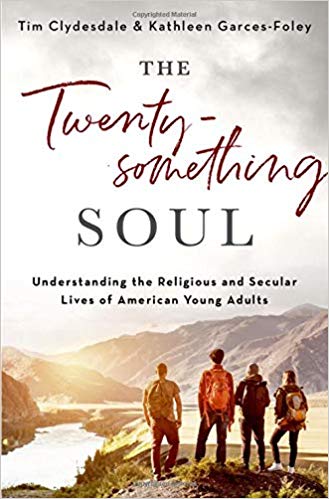The sky is not falling when it comes to religiosity among 20-somethings. No matter how many breathless blog posts and scary headlines you read about religious decline among young people, you should know that religious practice remains steady even as religious affiliation has declined.
 Tim Clydesdale and Kathleen Garces-Foley’s new book from Oxford University Press, The Twenty-Something Soul: Understanding the Religious and Secular Lives of American Young Adults, combines qualitative and quantitative analysis, providing context and coloring in some of the details through individual stories that easily get overlooked in the sea of statistics.
Tim Clydesdale and Kathleen Garces-Foley’s new book from Oxford University Press, The Twenty-Something Soul: Understanding the Religious and Secular Lives of American Young Adults, combines qualitative and quantitative analysis, providing context and coloring in some of the details through individual stories that easily get overlooked in the sea of statistics.
Today, I’ll lay out four takeaways from their research, and later this week I’ll offer a closer look at those who now identify as “None” or “unaffiliated.”
1. More Continuity Than Decline
The biggest takeaway from The Twenty-Something Soul is that “the beliefs and practices of today’s 20-somethings demonstrate continuity far more than decline” (16). Contrary to popular wisdom, we are not seeing massive declines in religiosity among people in their 20s.
That’s not to say there is no decline. Two out of five 20-somethings attended a worship service regularly during the 1970s, and now it’s just slightly more than 1 out of 3. What stands out the most is the “increasing proportion of 20-somethings who never attend worship and the decreasing proportion of those who do occasionally” (41). In other words, levels of devotion remain remarkably stable, while those who have attended church less frequently are doing so even less these days.
2. Clustering in Congregations
More continuity than decline? You may scratch your head and think, Not at my church! We hardly have any 20-somethings anymore. The research must be flawed.
But both your experience and the research can be right. The 1 in 3 20-somethings who attend worship regularly “do not distribute themselves evenly across religious institutions but cluster within young-adult-friendly congregations” (7). That means 20-somethings gravitate toward congregations that already have twentysomethings.
This is why some churches may have dozens of people in their 20s and 30s while other churches have only a handful or none at all. The overall percentage of young people who attend church hasn’t changed too much, but for many congregations the decline feels massive because all the 20-somethings are at the church across town.
(If you’re looking for easy answers as to how to fix this problem, The Twenty-Something Soul doesn’t offer any. It’s a book of description, not prescription. But Growing Young, a book I reviewed a couple years ago, is worth consulting if you’re interested in churches that attract and keep 20-somethings.)
3. Evangelical Dominance
If you’re curious about the breakdown of religiosity among 20-somethings, here is what the research showed.
- Three out of 10 are evangelical Protestants.
- Three out of 10 are None.
- 18 percent are Catholic.
- 14 percent belong to mainline churches.
- 1 out of 11 belong to another religion.
Among the 7 out of 10 who identify with a religion, 6 of the 7 choose Protestant or Catholic (24).
What does this mean for evangelicals? There are 6 million 20-somethings who fit the category of “Active Evangelical” in America. If you were to bring them all together, they’d make up the nation’s second-largest city—ahead of L.A. and behind New York (113). In the chapter they devote to describing evangelicals, the authors focus on two congregations: Consolidated Baptist Church in Lexington, Kentucky (a large, Black congregation that affiliates with the Southern Baptist Convention), and New Life Fellowship in Queens, New York (a multiracial evangelical congregation).
The surprising takeaway from the research on evangelicals is the enthusiasm among those who identify themselves this way. Here’s a startling statistic:
“The proportion of active evangelicals is more than twice the proportion of active mainliners or active Catholics, while the proportion of estranged evangelicals is at least six-times smaller than the proportion of estranged mainliners or estranged Catholics” (127).
The researchers believe we will see future generations of Protestants (especially evangelicals) and Catholics, but a 40 percent decline in 20-somethings affiliated with mainline churches by the latter part of the 2040s (110).
4. Christianity and Expressive Individualism
Most 20-somethings today “experience the world less as sets of institutions prescribing standard life scripts and more as nodes on a network from which they can freely choose cultural symbols, strategies, and interpretations” (18). The researchers describe them as “practical and postmodern.”
What does this mean? Most 20-somethings are looking for religious institutions that fulfill spiritual needs or provide social stability as they embark on a personal quest for authenticity and self-discovery. What matters most is the authenticity of the 20-something, not the authenticity of the religious tradition being adopted. Among active Catholics and evangelicals, however, the desire to belong to an authentic religious tradition shows up stronger, with young people expressing their desire to find a church that preaches the Word unadulterated or that takes seriously the church’s catechism.
For more along these lines, take a look at a series I wrote last year on expressive individualism (the idea that the purpose of life is to find and express yourself) and the challenges this way of seeing the world raises for the church. It’s not surprising to see new research showing some of the signs of the “be true to yourself” mentality across denominational lines.
Later this week, we’ll look at some surprising findings about the Nones.


















